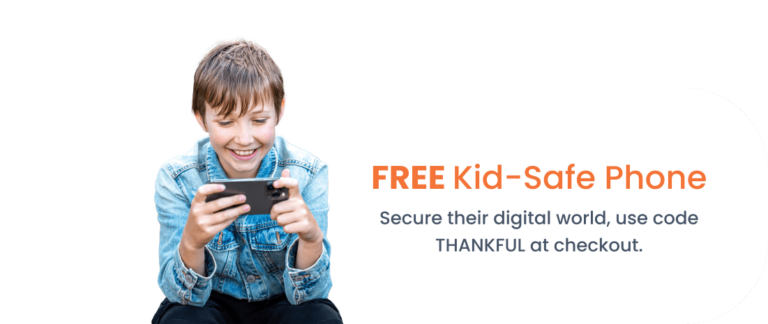Tick tock goes the clock—and the countdown until your kids inevitably ask you if they can download TikTok.
If you’re a parent in the twenty-first century, you’ve no doubt heard of TikTok. It’s no surprise; with over 1 billion people using the app every month, all over the world, TikTok is one of the most popular social media sites out there.
Kids and teens are especially enamored by TikTok. In fact, the New York Times reports that at least one third of TikTok’s 49 million American users are ages 14 and under. That’s more people than the entire population of Zimbabwe!
But just how appropriate is TikTok for kids? Are there any benefits to letting your kiddos explore the app? Is TikTok safe to use now in 2023?
The answers to all these questions (and more) lie in this article. So without further ado, let’s dive into Troomi’s ultimate parent guide to TikTok.
What Is TikTok? How Does it Work?
Before we answer the big Qs about TikTok for kids, let’s learn a little bit more about the app itself.
TikTok is a popular social media app that lets users of all backgrounds create, watch, and share short-form videos directly from their phone. These videos (appropriately called TikToks) can range anywhere from 15 seconds to ten minutes in length, though most tend to err on the shorter side of things.
TikToks can be about anything—and I mean anything. Some content creators make TikToks that show off their outfit, others share cool science facts, while still others write, produce, and star in their own short comedy films. One of my personal favorite TikTok accounts even posts daily trivia questions!
TikTok was first launched in China in 2016 under the name Dǒuyīn, before arriving in the United States in September 2017. After a while (and largely thanks to the COVID-19 pandemic), TikTok became a sensation. Once it gained popularity, it quickly overtook other social media services like Instagram and Twitter to become one of the most-used social media sites in the world.
Pros of Using TikTok for Kids
Now that we know a bit more about TikTok, let’s look at some of the potential benefits that it can have for kids.
- TikTok can be educational. Amidst all the dancing and comedy videos lie educational TikToks that explore a variety of topics, ranging from zoology to chemistry to linguistics. These videos usually explain difficult concepts in a succinct and clear way that most kids can understand.
- TikTok inspires creativity. TikTok is a haven for creativity. Many TikToks feature writing advice, sketchbook tours, and painting tutorials that are made with kids in mind. If your child has a creative mind, TikTok could inspire them to try out a variety of different creative pursuits.
- TikTok introduces kids to new cultures. As an international social media platform, TikTok introduces users to cultures and traditions from all around the world. For example, it’s not rare to see videos in foreign languages. Who knows—TikTok might even teach your child some words in a new language or introduce them to an unfamiliar kind of cooking!
- TikTok helps users stay connected. Like all social media, TikTok emphasizes connection. When users see a TikTok that makes them laugh, they can send it to their buddy and start a conversation. Users can also interact with other people’s videos by commenting, sharing, dueting, or stitching their own creations beside the original video, making it an extremely social application.
Cons of Using TikTok for Kids
As you can see, there are some definite benefits to TikTok—but there are just as many drawbacks. Wondering why TikTok is bad for kids? Let’s take a look at some of the bad things about TikTok.
- TikTok can be addictive. TikTok’s homepage (dubbed the For You Page, or FYP) uses a highly advanced algorithm that is designed to keep users scrolling. Once you start the scroll, it can be difficult to stop! Social media addiction has been linked to increased anxiety and depression, especially in kids and teens, so it might be smart to avoid the scroll altogether.
- TikTok can be detrimental to a child’s self-esteem. Between the dangers of social comparison, FOMO, and the ever present potential for cyberbullying, TikTok can be a real killer of self-esteem.
- Some TikToks contain mature content. While TikTok doesn’t allow pornography or graphic violence, TikToks with inappropriate language and mature themes can still make their way onto your child’s FYP. This could expose your child to themes and topics that they may not be mature enough to think about.
- TikTok is riddled with privacy concerns. If you’re an avid news reader like me, you’ve no doubt seen some headlines about TikTok’s privacy concerns. Like all social media apps, TikTok collects all sorts of data from its users. This includes personal information like the user’s name, location, IP address, contact list, and previous browsing history. It doesn’t matter if the user is 13 or 30, TikTok has their information.
How Old Should My Child Be to Get TikTok?
Now that we’ve talked about the pros and cons of TikTok for kids, let’s answer that big Q: how old should my child be to get TikTok?
According to Common Sense Media, TikTok is appropriate for teens 15 and up.
Just like when you’re deciding when to give your child a phone, however, the answer to this question depends on you and your child. Every child matures at their own speed. If you think that your kiddo is mature enough to handle the responsibility that comes with having social media before they’re 15, you may feel ready to go for it.
On the other hand, some kids may not be ready to explore TikTok until they’re older than 15. Nobody knows your child better than you do, so don’t be afraid to have a conversation and determine the best course of action for them!
How to Keep Your Child Safe on TikTok
If your child is active on TikTok, you’re likely wondering, “How can I make TikTok safe for my child?” Here are some safety precautions you can take to keep them safe as they Tik and they Tok.
- Use Family Pairing. Family Pairing is a pretty cool feature that allows parents and kids to connect their TikTok accounts. By linking your account to your child’s, you’re able to control your child’s privacy settings, monitor their screen time, and block inappropriate content from showing up on their feed.
- Turn on Restricted Mode. Like Family Pairing, Restricted Mode is a feature on TikTok that can help your child have a safe and enjoyable social media experience.
- Make your child’s account private. TikTok accounts for kids aged 13-15 are set to private by default, but the same can’t be said for anyone over 15. Make sure that your child’s account is set to private.This ensures that only people they know can see their posts.
- Teach your kids about social media safety. The Internet is a pretty fantastic invention, but it’s not without its dangers. Before your kids download TikTok, have a conversation about Internet safety. If they already know the basics, give them a refresher! Strengthening this foundation of online safety gives kids the tools they need to scroll without putting their personal safety at risk.
- Make TikTok a family activity. At its heart, TikTok is full of fun videos for users of all ages. As your child explores the app, take some time to scroll through their FYP with them. The benefits are threefold: you get to surreptitiously monitor what your child is watching on TikTok, they see that you’re interested in their hobbies, and you both get some precious bonding time in!
Why Is TikTok So Addictive?
Like all social media, TikTok can be pretty addictive, especially for children. Why is that?
Well, simply put, TikTok is addictive because it’s fun. Scrolling through the FYP means constant stimulation from a variety of creators and genres of video. Because of the vast variety of content that one can find on TikTok, it’s possible to scroll for hours on end.
The personalization of your child’s For You Page only makes the app more addicting. TikTok uses a highly advanced algorithm to learn exactly what type of videos users are interested in seeing. They then load each user’s FYP with these personalized videos, causing an endless stream of addictive entertainment.
For a more scientific answer, the reasoning behind TikTok’s addictive nature lies in the brain’s reward center. According to researchers at Brown University, giving and receiving “likes” on TikTok causes the brain to release dopamine, our body’s chemical key to happiness.
Eventually, the brain gets used to this increased amount of dopamine. When this happens, it requires increasingly larger amounts of the chemical to feel the same amount of joy. This is where the addiction cycle typically begins.
What to Do if Your Child Is Addicted to TikTok?
Unfortunately, despite all the effort to keep your child safe on TikTok, there’s still the chance that they fall into the trap of social media addiction. If this has happened to your child, don’t fret: there are a few things you can do to help.
- Discuss the problem. When it comes to addiction, you can’t find a solution without first having a discussion about it. Let your child know that you love them and support them, and that you want to work together to break their addiction.
- Make a plan with your child. After discussing the problem, come up with a plan that works for your kiddo. For example, maybe limit their TikTok time to 15 minutes on weekdays and 30 minutes on weekends. Remember: this should be a democratic plan-making session. Including your child in the process lets them know that you trust them and care about them.
- Set a time limit on your child’s TikTok. Many smartphones feature a time limit function that lets you limit how much time your child can spend on specific apps per day. Instead of deleting the app altogether, set a time limit on your child’s TikTok.
- Set your child’s TikTok to Restricted Mode. If your child’s TikTok isn’t already on Restricted Mode, consider turning it on. Limited functionality might make TikTok seem less glamorous. Eliminating some of TikTok’s features could help your child let the app go.
- Switch them to a Troomi phone. Troomi’s mission is to empower your kids and help them develop healthy technology habits. With a Troomi phone, your child will have access to a curated library of KidSmart® Apps that don’t include social media apps like TikTok.
- Talk to a professional. If your child’s TikTok addiction is starting to get in the way of their day-to-day life, they may need to talk with a professional. There are tons of therapists that can support kids as they work through the stages of screen addiction.
Should I Let My Child Get TikTok?
TikTok is an immensely popular app—but is TikTok safe for kids?
Not really. While TikTok has some benefits, the bad things about TikTok definitely outweigh the positives. Between addiction, privacy concerns, and potential exposure to mature content, your child is likely better off without the app.
While we at Troomi don’t recommend social media like TikTok for kids, our kid-friendly smart devices feature some handy KidSmart® Apps that can help your kiddos scratch that social itch while avoiding some of the potentially harmful elements.
Here are some cool apps like TikTok for kids:
Band. On BAND and BAND kids, users can stay connected with sports teams, scout troops, friends, and family. It’s a completely private social platform, giving kids a safe place to interact with each other while avoiding the negative aspects of popular social media.
Marco Polo. Marco Polo is one of my favorite apps to stay connected with friends and family. Users can film short videos and send them off to their closest pals and family members. The best part? Marco Polo is ad-free and doesn’t collect any personal data.
GroupMe. Does your child want to send pictures, videos, and texts to a group of their friends? They can do it on GroupMe! This easy-to-use app makes it possible for kids to create accessible group messages without incurring extra data charges.
All these apps (and more) are available on Troomi’s devices. Click here to learn more about Troomi, and be sure to come on back to the Troomi blog for regular updates that you won’t want to miss.


